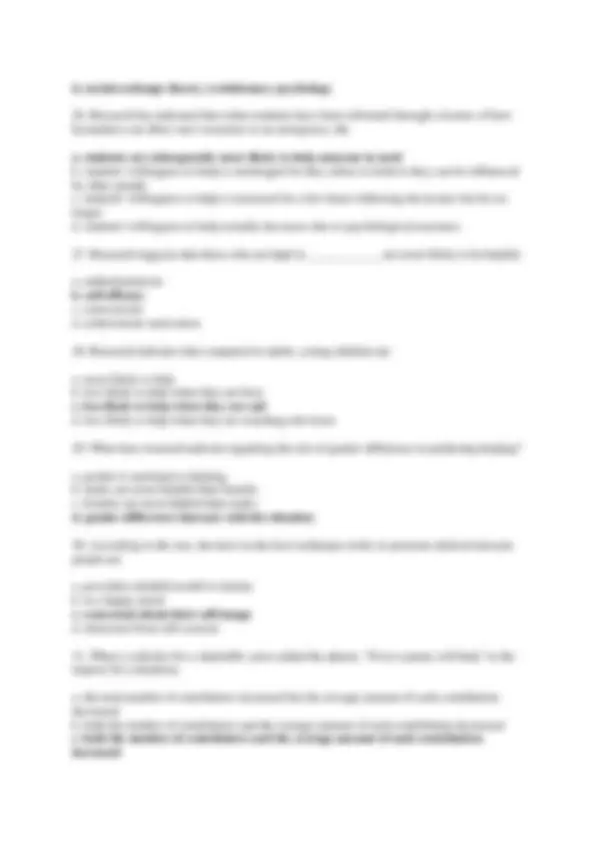


























Study with the several resources on Docsity

Earn points by helping other students or get them with a premium plan


Prepare for your exams
Study with the several resources on Docsity

Earn points to download
Earn points by helping other students or get them with a premium plan
Community
Ask the community for help and clear up your study doubts
Discover the best universities in your country according to Docsity users
Free resources
Download our free guides on studying techniques, anxiety management strategies, and thesis advice from Docsity tutors
Unit wise multiple choice questions with correct answer.
Typology: Exercises
1 / 32

This page cannot be seen from the preview
Don't miss anything!

























Presenting people with a multiculturalist perspective might lead them:
To be more accurate about group differences
To show stronger stereotypes
To show weaker stereotypes 4. Both A and B
“Aversive racism” suggests that people discriminate against racial outgroups when:
They can attribute others’ behavior to racism 2. They can attribute their behavior to non-racism
They can attribute an outgroup member’s actions to their situation
They notice there is very little ambiguity
During an interracial interaction, for whom is executive control depleted?
Whites
Blacks 3. Both
Neither
What is a typical result in an interaction, after a person has proven their “moral credentials?”
They are more likely to control their prejudiced thoughts 2. They are more likely to express their prejudices
Neither
It depends
Which of the following tends to be a stronger predictor of intergroup discrimination?
Stereotyping 2. Emotional prejudice
Attitudes
Behavior
Which emotion makes people stereotype relatively more? 1. Anger
Sadness
Both
Neither
In studies of intergroup emotions theory (IET), which traits do people respond more quickly to?
Traits that match their self-concept but not necessarily their ingroup concept
Traits that match their ingroup concept but not necessarily their self-concept 3. Traits that match their self-concept and their ingroup concept
None of the above
27 .________is differential treatment based on group membership including age, sexual orientation, race, religion etc.
Research indicates that people perform best when their coactor is
not watching them 2. slightly superior
of the opposite sex
highly competitive
Social facilitation and social loafing have been explained in terms of difference in 1. evaluation concern
informational influence
cognitive dissonance
group polarization
Which process helps explain both social loafing and deindividuation?
self-censorship
minority influence 3. diffusion of responsibility
group polarization
Research indicates that being in a crowd _________ positive reactions and _________ negative reactions. a. intensifies; intensifies b. weakens; intensifies c. intensifies; weakens d. weakens; weakens
Which of the following is false? a. groups of friends loaf less than groups of strangers b. Israel's communal kibbutz farms have outproduced Israel's noncollective farms c. research completed in Japan, Thailand, and India indicates that social loafing does not occur in less individualistic, more group-centered cultures d. students pumped exercise bikes more energetically when they knew they were being individually monitored than when they thought their output was being pooled with that of other riders
Experiments show that people in groups loaf less when a. the task is challenging b. they are in an unfamiliar setting c. they have a strong sense of external control d. the task is routine
d. the individuals who were relatively unprejudiced became more prejudiced and the individuals who were relatively prejudiced became less prejudiced
c) Love d) Social influence 4 4. Conformity is first systematically studied by the researcher______ a) Albert Ellis b) Solomon Asch c) Carl Roger d) Alfred Adler 4 5._________means refusing to go along with group, include status within a group, power and desire to be unique. a) Conformity b) nonconformity c) Determination d) Non compliance 4 6. _________Behaviour is in which individuals match their action to those of others a) Asynchronous b) Matching c) Symptomatic d) Synchronous 4 7.______are ones that simply describe what most people do in a given situation. a) Descriptive norms b) Non descriptive norms c) Injunctive norms d) Non injunctive norms 4 8.________are ones that specify how people ought to behave i.e. approved or disapprove behaviour in a given situation. a) four a) Descriptive norms b) Non descriptive norms c) Injunctive norms d) Non injunctive norms 4 9.__________is a tactic of getting others to say “yes” to you requests a) Social influence b) Conformity c) Compliance d) Social cognition 5 0.________ technique involves presenting target people with small request and then following up with a larger request – the one desired all along a) Low ball b) Foot in the door c) Door in the face d) Door in the foot
d. social-exchange theory; evolutionary psychology